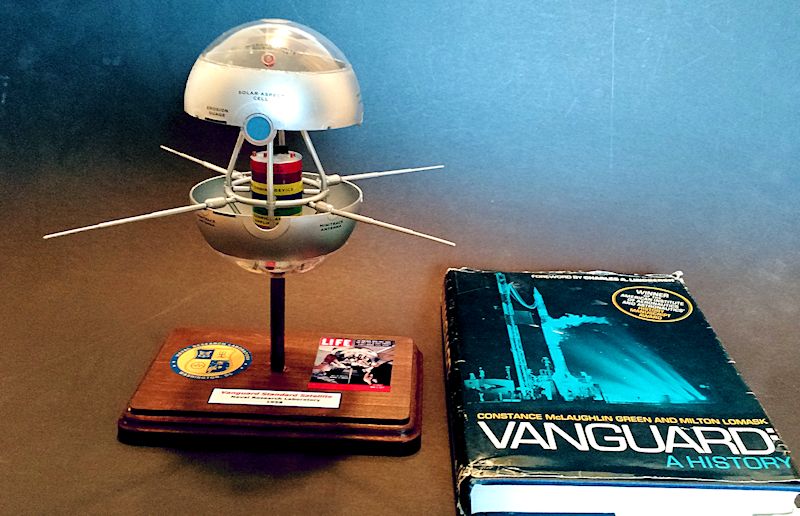
| HISTORY |
Hawk 1/5 Vanguard Satellite
| KIT #: | HL 603/12 |
| PRICE: | $21.99 SRP) |
| DECALS: | One option |
| REVIEWER: | Les Dorr Jr. |
| NOTES: | Reissue of 1958 Hawk kit |

| HISTORY |
Space Race!
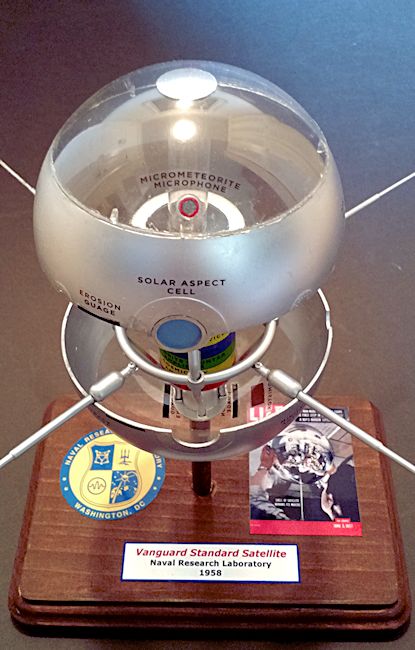 In
those heady days nearly six decades ago, space fever had seized a sizable
portion of the American public. Partly it was fueled by TV space operas such
as Space Patrol and Tom Corbett, Space Cadet, along with science-oriented
shows like Disney's three-part space series. Perhaps even more, there was a
keen desire to surpass those godless commies who had staked out the orbital
high ground with the launch of Sputnik 1 and 2 in late 1957.
In
those heady days nearly six decades ago, space fever had seized a sizable
portion of the American public. Partly it was fueled by TV space operas such
as Space Patrol and Tom Corbett, Space Cadet, along with science-oriented
shows like Disney's three-part space series. Perhaps even more, there was a
keen desire to surpass those godless commies who had staked out the orbital
high ground with the launch of Sputnik 1 and 2 in late 1957.
The United States had its own earth satellite programs. The U.S. Army's effort, led by Werner von Braun, focused on using a modified Redstone missile called the Jupiter-C as a launch vehicle. The Navy's contribution was the Vanguard booster derived from the quasi-civilian Viking sounding rocket, while the Naval Research Laboratory built the Vanguard satellite itself. The Eisenhower Administration preferred Vanguard, in part because it didn't have the Jupiter-C's military heritage.
The “standard” Vanguard satellite was an aluminum sphere 20 inches in diameter, into which experiments could be mounted. There also was a much smaller “minimum” Vanguard satellite--often compared to a “grapefruit”--about six inches in diameter.
The Vanguard project was not very productive, as space historian and modeler Mat Irvine explains in the instruction sheet: “Only three of the 11 Vanguard orbital rocket launches were successful. After there had been two launch failures, Vanguard 1 achieved orbit on March 17, 1958, on board Vanguard TV-4, becoming America's second artificial satellite, after Explorer 1 (January 31, 1958.)”
Mat also notes that the Hawk model is almost an exact match for the Vanguard standard satellite launched April 28, 1958, which failed to make it into orbit.
(As an interesting note, Vanguard 1 and its upper stage are still in orbit being the oldest surviving man-made items in space. Ed)
| THE KIT |
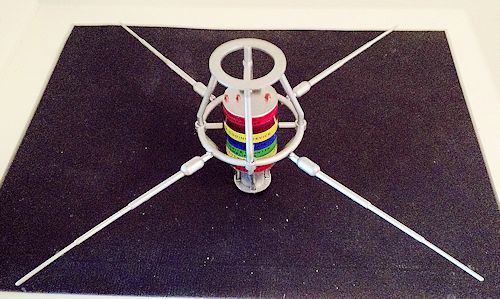 Round 2
Models has been resurrecting ancient MPC, Hawk and Lindberg kits for several
years, and this is a reissue of a 1958 Hawk kit. It includes 23 parts molded
in gray plastic, and five clear parts, two of which are top and bottom domes
designed to show off the model's interior. There are no molding defects or
flash despite the kit's antiquity. The kit is designed to build up into an
“educational” display, with an experiment package and supporting hardware
inside. The decal sheet has labels for the interior experiments and several
pieces of exterior equipment.
Round 2
Models has been resurrecting ancient MPC, Hawk and Lindberg kits for several
years, and this is a reissue of a 1958 Hawk kit. It includes 23 parts molded
in gray plastic, and five clear parts, two of which are top and bottom domes
designed to show off the model's interior. There are no molding defects or
flash despite the kit's antiquity. The kit is designed to build up into an
“educational” display, with an experiment package and supporting hardware
inside. The decal sheet has labels for the interior experiments and several
pieces of exterior equipment.
The pictorial instructions are easy to follow, with extensive color callouts and a decal placement diagram. Note that the colors given for the exterior satellite shell are either gold or silver, but the real deal was bright aluminum.
| CONSTRUCTION |
Before I put glue to styrene, I considered how I wanted the finished model to look, and that influenced how I built it. Dry-fitting the parts suggested that even with the clear top and bottom pieces, not much of the interior – the star of the show – would be palinly visible. So I opted for an “exploded”display.
T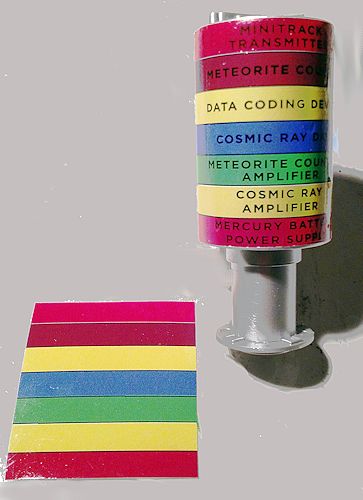 he
first step was gluing the central instrumentation package together. The
instructions call out different colors for the various instruments in the
stack. I decided masking each layer would be difficult and time-consuming,
so I created a multicolored decal using Gimp graphics software. I painted
the package overall silver, applied the homemade decal, then overlaid the
kit decals showing the instrument names. Next, I painted and cemented the
remaining parts of the central instrument package. To create the “exploded”
look, I super-glued a clear plastic cylinder atop the assembly to hold the
upper half of the satellite a sufficient distance from the lower half.
he
first step was gluing the central instrumentation package together. The
instructions call out different colors for the various instruments in the
stack. I decided masking each layer would be difficult and time-consuming,
so I created a multicolored decal using Gimp graphics software. I painted
the package overall silver, applied the homemade decal, then overlaid the
kit decals showing the instrument names. Next, I painted and cemented the
remaining parts of the central instrument package. To create the “exploded”
look, I super-glued a clear plastic cylinder atop the assembly to hold the
upper half of the satellite a sufficient distance from the lower half.
I painted the two opaque satellite halves bright silver and glued the solar aspect cell and ionization chamber parts into place on the upper part. I painted and installed the four micrometeorite microphones on the two clear domes. It's best to use a clear parts cement to avoid fogging the plastic, both for this step and the next – attaching the see-through parts to the top and bottom halves.
Using Aleene's white tacky glue, I installed the instrument package assembly onto the bottom clear dome. My kit was missing the locating pin shown in the instructions, so it took some fiddling to place it correctly. When everything was set, I used clear parts cement to attach the upper half to the plastic cylinder I installed earlier.
Important note: If you build the kit as intended with the two halves cemented together do not fill the seam! The actual Vanguard Standard Satellite was constructed in two halves, and photos show a thin but noticeable line between them. You may want to fill the seam where the antennas, solar cell and ionization chamber project, because the “circles” were solid parts.
| COLORS & MARKINGS |
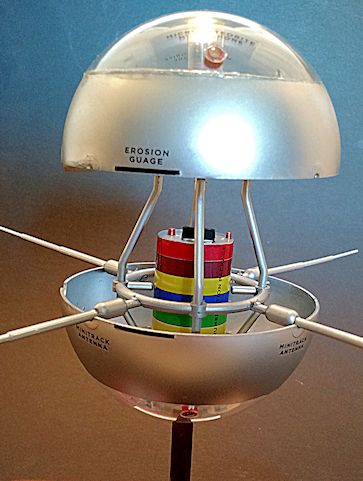 I
painted all the parts prior to assembly. Everything should be bright
aluminum or silver except the layers of the instrumentation package and some
details on the microphones.
I
painted all the parts prior to assembly. Everything should be bright
aluminum or silver except the layers of the instrumentation package and some
details on the microphones.
To create the “educational” feel, I applied most of the numerous instrument name decals to the outer shell. The large “PROJECT VANGUARD” and smaller “Naval Research Laboratory” text seemed garish to me, so I left them off.
I chose not to use the clear plastic kit stand. Instead, I stained a craft store wooden base and mounted the satellite using a stained wood dowel. I created an NRL logo and appropriate Life magazine cover with Gimp, and attached them and a nameplate with spray adhesive.
| CONCLUSIONS |
The Vanguard satellite kit is fairly easy to assemble. Built out-of-the-box, it's an impressive model that looks great on the shelf. More dedicated modelers can install all the instrument wiring and even LED lighting to show off the colorful interior. Either way, the model is an excellent reminder of the early days of U.S. space exploration.
| REFERENCES |
https://www.nasa.gov/content/vanguard-satellite-1958 http://www.nasa.gov/centers/goddard/about/didyouknow_prt.htm http://natedsanders.com/historic_1950_s_model_of_the_vanguard_1_satellite_-lot15459.aspxhttp://rockets.utena.su/images/spaceageposter/weatherEyeSatellite3.jpg
August 2015
If you would like your product reviewed fairly and fairly quickly, please contact the editor or see other details in the Note to Contributors.